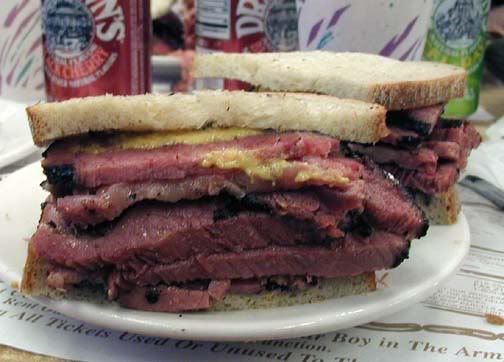
Bread has been consumed with other food since its creation in the Neolithic Era, but the concept of the sandwich is a more recent development. In 17th century Netherlands historians observed meat being sliced and placed between bread, but sandwiches truly gained relevance in the 19th century, when with the rise of an industrial working class in Spain and England quick, portable meals became in demand. By the onset of the 20th century the sandwich had spread to America, where it soon became a fundamental part of American cuisine. It was quite a long time ago, but when this Sandwich Guy was only a little knish, sandwiches were ubiquitous in the lunch room. Bologna on white bread, tuna on rye, peanut butter and jelly; these combinations became staples of my diet.
The true etymology of "sandwich" remains up to debate, but the most compelling story of the origin of the name of the greatest food of all time concerns an English noble named John Montagu, the Fourth Earl of Sandwich (referring to the town of Sandwich, whose name comes from the Old English sandwic meaning "sand village," or "Place on the sand.") According to legend, Montagu was an avid gambler, who one night in 1762 was hungry but too busy gambling to stop for a meal. Montagu asked a waiter for roast beef between two slices of bread, which he could hold in one hand while continuing his gambling with the other. This invention allowed Montagu to keep his hands grease-free for optimal gambling, and soon it caught on with his friends, who began to order the "same as Sandwich." Thus, from the dark gambling rooms of 18th century England, there was set off an irrepressible chain of events which resulted in the serendipitous birth of The Sandwich Guy just a few years ago.
But, with etymological disputes aside, before we begin our journey within the realm of the sandwich we must define what exactly is a sandwich. Dictionary.com defines a sandwich as "two or more slices of bread or the like with a layer of meat, fish, cheese, etc. between each pair." This definition is highly American-zed and just seems outdated. Merriam-Webster's definition of a sandwich is slightly more flexible, with the inclusion of "a split roll having a filling in between," and also "one slice of bread covered with food." This definition allows for our beloved hot dogs and lobster rolls to be included in the sandwich category, not to mention the open-face sandwich; after all, who could live without some moist tuna salad on top of a piece of crispy rye bread with a melty layer of swiss cheese to top it off ? Not this Sandwich Guy.
Merriam-Webster comes close, but The Sandwich Guy's definition of a sandwich is even more flexible and all-compassing. Yes, a sandwich can include two slices of bread, but for us "the like" will include also any form of "wrap," including of course the Mexican burrito and Greek souvlaki. Our definition of "bread" includes bread that can be cut into slices, but also bread that cannot be cut into slices, including bagels and tortillas, as well as pita bread. Any sort of a "patty" works as the form of a sandwich as well. The filling of a sandwich can range from an assortment of meats, fishes and cheeses, to any sort of vegetable filling. In fact, the "filling" of a sandwich can consist of any sort of food whatsoever, from layers of hot pastrami to a fried Oreo (Oh yeah, it's out there somewhere).
So now that we have established the ground rules, it is time for the fun part. The Sandwich Guy resides in the Park Slope neighborhood of Brooklyn, NY, so naturally our sandwich journey will begin within the friendly confines of these steep, narrow brownstone-riddled streets. I urge all of my readers (the at least 3 or 4 of you) to send me your favorite sandwiches; maybe we can go eat some together.
I might not be quite the gambler as the nobleman Montagu once was, but I at least play a pretty mean game of Texas Hold'em.
No comments:
Post a Comment